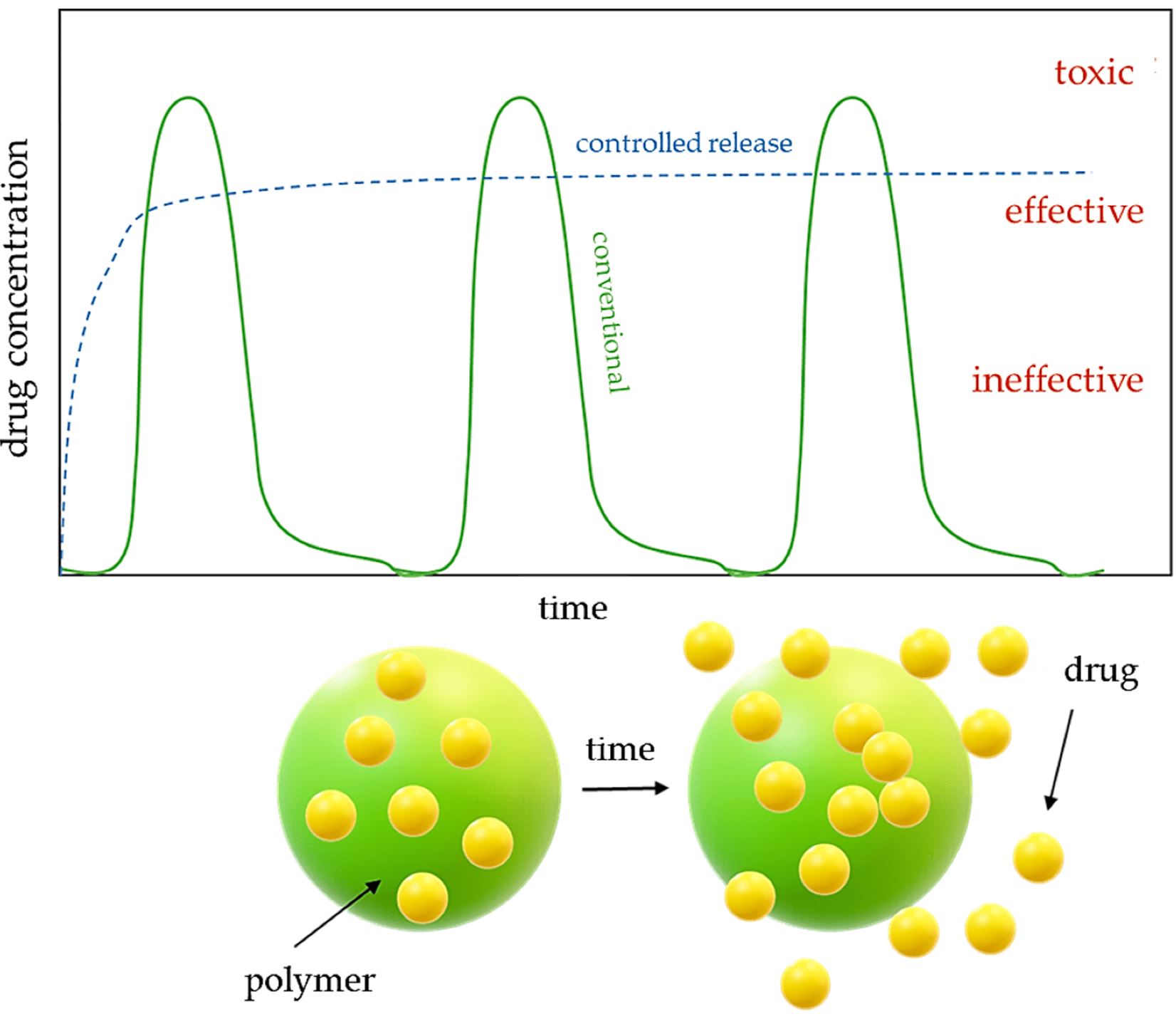Advanced Drug Carriers: A Review of Selected Protein, Polysaccharide, and Lipid Drug Delivery Platforms

Abstract
Studies on bionanocomposite drug carriers are a key area in the field of active substance delivery, introducing innovative approaches to improve drug therapy. Such drug carriers play a crucial role in enhancing the bioavailability of active substances, affecting therapy efficiency and precision. The targeted delivery of drugs to the targeted sites of action and minimization of toxicity to the body is becoming possible through the use of these advanced carriers. Recent research has focused on bionanocomposite structures based on biopolymers, including lipids, polysaccharides, and proteins. This review paper is focused on the description of lipid-containing nanocomposite carriers (including liposomes, lipid emulsions, lipid nanoparticles, solid lipid nanoparticles, and nanostructured lipid carriers), polysaccharide-containing nanocomposite carriers (including alginate and cellulose), and protein-containing nanocomposite carriers (e.g., gelatin and albumin). It was demonstrated in many investigations that such carriers show the ability to load therapeutic substances efficiently and precisely control drug release. They also demonstrated desirable biocompatibility, which is a promising sign for their potential application in drug therapy. The development of bionanocomposite drug carriers indicates a novel approach to improving drug delivery processes, which has the potential to contribute to significant advances in the field of pharmacology, improving therapeutic efficacy while minimizing side effects.
Introduction
In today’s world, developing modern therapies and strategies for delivering active substances requires innovative approaches [1,2] that balance therapeutic effectiveness with minimizing adverse effects. Traditional drug delivery methods include classical approaches such as oral, intravenous, dermal, or muscular administration of the active substance without the use of special carriers [3,4]. This works by directly delivering the active substance to the body, but has several significant problems. With oral delivery, drugs are prone to degradation in the gastrointestinal tract, which can lead to a loss of efficacy. In addition, active substances may be susceptible to rapid excretion from the body, reducing their blood concentration and therapeutic efficacy [5].
Traditional drug delivery methods are often characterized by a lack of selectivity, meaning that active substances spread throughout the body, affecting both diseased and healthy tissues or cells [6]. This phenomenon can lead to side effects and reduce the overall effectiveness of therapies. In contrast, drug carriers are an advanced tool, enabling the precise delivery of active substances where they are needed, representing a significant advancement in the therapeutic field. Drug carriers enable the targeted delivery of active substances. This phenomenon, known as targeting, is becoming a key element in improving treatment efficacy [7,8]. Drug-targeting approaches are based on precisely targeting drugs to disease areas, i.e., specific tissues or cells in the body, thus minimizing the impact on unaffected areas. These approaches lead to the accumulation of drugs in pathological sites, thereby increasing the effectiveness of the treatment. Targeted tissue delivery is often based on the area’s unique physical, chemical, or biological properties [9,10]. For example, in the case of cancerous tumors, carriers can be engineered to preferentially accumulate in the blood vessels surrounding the tumor (enhanced permeability and retention (EPR) effect), thus enabling the selective delivery of the drug to the tumor area [11]. For the treatment of neurological diseases, drug carriers can be designed to penetrate the blood–brain barrier and deliver active substances directly to the brain [12]. In turn, introducing receptors specific to the ligands on the surface of target cells allows for targeted delivery to the specific cells of a particular organ or tissue [13].
In addition, drug carriers allow for the controlled release of the active substances, which increases drug stability and minimizes loss of activity. Below (Figure 1), a scheme for the controlled release of active substances from drug carriers is presented. The multiple conventional drug dosages have been presented by the green circle line. During this delivery system, the drug portion is released immediately after its administration, which may have intense potential side effects and thus negatively affect the treatment. In the case of controlled drug release (blue dashed line), the active substance is released over a prolonged time period at a predetermined rate.
Many aspects are analyzed considering drug delivery approaches involving both conventional delivery and delivery using adequate carriers. In conventional delivery, drugs are spread in the body via the blood, which can lead to the uncontrolled distribution of active substances and their accumulation within healthy tissues or cells as well. In the context of drug carriers, efficient blood circulation is crucial, as it enables the precise delivery of the active substance to the targeted tissues [14,15]. Carriers of active substances are designed to move through the bloodstream in an optimized manner. The importance of the structure of drug carriers and their physicochemical properties is crucial to maintaining their stability in the blood, minimizing interactions with the immune system, and efficiently delivering drugs. Hence, they are designed with several key factors in mind. An important aspect is the carrier’s structure, which must be tailored to allow for efficient circulation in the blood. Proper size, shape, and surface functionalization affect the bioavailability of the carrier and its ability to avoid early removal from the body. Additionally, carriers must show physicochemical stability to maintain structural integrity during their transport through the bloodstream. This is important to ensure drug delivery efficiency and reduce potential side effects. Properties that minimize interactions with the immune system are also crucial. Carriers must avoid recognition by immune system cells, which can lead to the neutralization or elimination of carriers before reaching their target sites [16,17,18].
In traditional drug delivery, active substances are administered systemically into the body, often leading to their distribution in tissues and organs. In this approach, the targeting of substances to specific cells is limited, potentially increasing the risk of side effects and reducing therapeutic efficacy. In contrast, carrier-based drug delivery enables increased precision in cellular uptake. Carriers can facilitate cellular penetration, improving therapeutic efficacy. In addition, functionalizing carriers with receptors specific to ligands present on the surface of target cells increases uptake selectivity, minimizing the impact on healthy cells. As a result, carrier-mediated drug delivery focuses on increasing cellular uptake efficiency, resulting in more targeted and effective treatments with minimal side effects [19,20].
Compared to traditional delivery methods, drug carriers represent a novel approach, potentially revolutionary in improving the efficacy of therapies, especially in the context of cancer treatment [21]. Synthetic and natural polymers represent two different categories of materials used in drug carrier design. Synthetic polymers, such as poly(acrylic acid) or poly(ethylene glycol), have a controlled chemical structure, making fine-tuning their physicochemical properties possible. On the other hand, natural polymers, such as cellulose or albumin, are derived from natural sources and often exhibit better biocompatibility. A similarity is the ability of both types of polymers to form carriers with controlled release of the active substance. However, natural polymers often exhibit better biodegradability and less toxicity, which can be beneficial in terms of eliminating their potential side effects [22,23].
Natural-derived polymers exhibit several important properties that provide advantages over synthetic polymers in drug carrier design:
- Biocompatibility: natural polymers are often natural components of the body (e.g., hyaluronic acid), which minimizes the risk of immune reactions and provides better biocompatibility compared to synthetic polymers.
- Biodegradability: most natural polymers are naturally degradable in the body, eliminating the need for surgical removal after treatment, which is particularly important, especially in terms of minimizing side effects and body burden.
- Diverse sources: polymers of natural origin, such as proteins, polysaccharides, or nucleic acids, can be obtained from a variety of sources, making it possible to tailor their properties to specific applications.
- Significant impact on biological interactions: natural polymers often exhibit the ability to interact with cells and tissues in the body, which can be used to increase the selectivity of drug carriers and facilitate cellular uptake [24,25,26].
As a result, the properties of natural polymers make them an attractive choice for drug carrier design due to their naturalness, biocompatibility, and potential to minimize negative effects on the patient’s body.
One of the areas of intense research focused on improving therapeutic efficiency is the field of bionanocomposites, which serve as advanced drug carriers by combining attractive features of nanomaterials with materials of natural origin [27,28].
Nanocomposites represent an intriguing combination of diverse materials, such as fats, proteins, and polysaccharides, forming comprehensive structures with nanometric dimensions. This unique class of materials has found its application as drug carriers, enabling the efficient delivery of active substances within the body [29,30,31,32]. In a therapeutic context, nanocomposites exhibit a number of promising features, such as stability, controlled drug release, and the ability to deliver active substances in a targeted manner [33,34].
Drug carriers based on nanocomposites utilizing biopolymers, such as polysaccharides, constitute a fascinating research area. These natural polymers, including chitosan [35] and cellulose [36], are characterized by biocompatibility and biodegradability, making them attractive candidates for medical applications. Additionally, nanocomposites can be tailored by introducing nanoadditives in the form of fats, opening up new perspectives for effectively transporting lipophilic substances [37].
Contemporary approaches to therapy and the delivery of active substances are gaining significance in the context of minimizing side effects while increasing therapeutic efficacy [38]. The development of modern therapies requires innovative strategies, and one of the areas of intense research is the field of biocomposites and bionanocomposites, which serve as advanced drug carriers [39]. Research on this topic is fundamental, drawing attention to the emerging applications of composites and nanocomposites as drug carriers. Their unique characteristics make them comprehensive structures. This particular class of materials finds practical application in efficiently delivering active substances within the body. Hence, the main goal was to characterize the latest achievements in the field of development of biocomposites and bionanocomposites as carriers of active substances. The analysis of the newest literature underscores the importance of this topic, especially in the context of improving the effectiveness of treatments. Additionally, conventional drug delivery methods contribute to the distribution of drugs within the whole body, while the delivery of active substances via the adequate carriers may lead to their accumulation mostly within the affected site, thereby reducing occurring side effects (accompanying among other treatments of cancer using cytostatic drugs) [40,41,42].
Download the research paper as PDF here Advanced Drug Carriers
or read it here
Jamroży, M.; Kudłacik-Kramarczyk, S.; Drabczyk, A.; Krzan, M. Advanced Drug Carriers: A Review of Selected Protein, Polysaccharide, and Lipid Drug Delivery Platforms. Int. J. Mol. Sci. 2024, 25, 786. https://doi.org/10.3390/ijms25020786
Read more on Alginates here:


